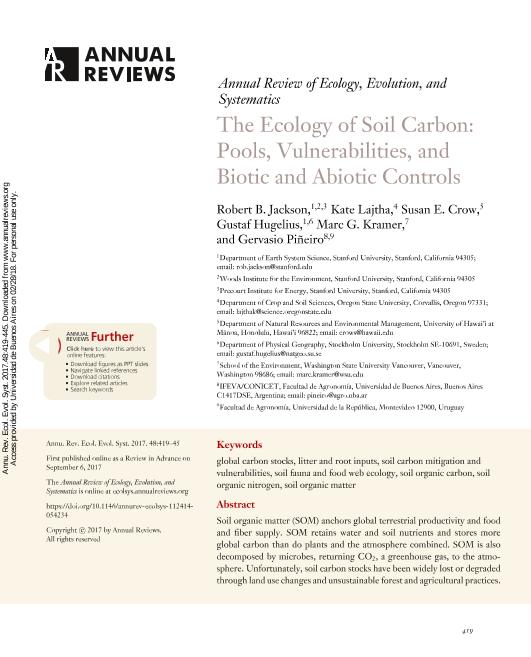Mostrar el registro sencillo del ítem
dc.contributor.author
Jackson, Robert B.

dc.contributor.author
Lajtha, Kate
dc.contributor.author
Crow, Susan E.
dc.contributor.author
Hugelius, Gustaf
dc.contributor.author
Kramer, Marc G.
dc.contributor.author
Piñeiro, Gervasio

dc.date.available
2018-06-29T17:41:03Z
dc.date.issued
2017-11
dc.identifier.citation
Jackson, Robert B.; Lajtha, Kate; Crow, Susan E.; Hugelius, Gustaf; Kramer, Marc G.; et al.; The Ecology of Soil Carbon: Pools, Vulnerabilities, and Biotic and Abiotic Controls; Annual Reviews; Annual Review Of Ecology Evolution And Systematics; 48; 11-2017; 419-445
dc.identifier.issn
1543-592X
dc.identifier.uri
http://hdl.handle.net/11336/50698
dc.description.abstract
Soil organic matter (SOM) anchors global terrestrial productivity and food and fiber supply. SOM retains water and soil nutrients and stores more global carbon than do plants and the atmosphere combined. SOM is also decomposed by microbes, returning CO2, a greenhouse gas, to the atmosphere. Unfortunately, soil carbon stocks have been widely lost or degraded through land use changes and unsustainable forest and agricultural practices. To understand its structure and function and to maintain and restore SOM, we need a better appreciation of soil organic carbon (SOC) saturation capacity and the retention of above- and belowground inputs in SOM. Our analysis suggests root inputs are approximately five times more likely than an equivalent mass of aboveground litter to be stabilized as SOM. Microbes, particularly fungi and bacteria, and soil faunal food webs strongly influence SOM decomposition at shallower depths, whereas mineral associations drive stabilization at depths greater than ∼30 cm. Global uncertainties in the amounts and locations of SOM include the extent of wetland, peatland, and permafrost systems and factors that constrain soil depths, such as shallow bedrock. In consideration of these uncertainties, we estimate global SOC stocks at depths of 2 and 3 m to be between 2,270 and 2,770 Pg, respectively, but could be as much as 700 Pg smaller. Sedimentary deposits deeper than 3 m likely contain >500 Pg of additional SOC. Soils hold the largest biogeochemically active terrestrial carbon pool on Earth and are critical for stabilizing atmospheric CO2 concentrations. Nonetheless, global pressures on soils continue from changes in land management, including the need for increasing bioenergy and food production.
dc.format
application/pdf
dc.language.iso
eng
dc.publisher
Annual Reviews

dc.rights
info:eu-repo/semantics/openAccess
dc.rights.uri
https://creativecommons.org/licenses/by-nc-sa/2.5/ar/
dc.subject
Global Carbon Stocks
dc.subject
Litter And Root Inputs
dc.subject
Soil Carbon Mitigation And Vulnerabilities
dc.subject
Soil Fauna And Food Web Ecology
dc.subject
Soil Organic Carbon
dc.subject
Soil Organic Matter
dc.subject
Soil Organic Nitrogen
dc.subject.classification
Agricultura

dc.subject.classification
Agricultura, Silvicultura y Pesca

dc.subject.classification
CIENCIAS AGRÍCOLAS

dc.title
The Ecology of Soil Carbon: Pools, Vulnerabilities, and Biotic and Abiotic Controls
dc.type
info:eu-repo/semantics/article
dc.type
info:ar-repo/semantics/artículo
dc.type
info:eu-repo/semantics/publishedVersion
dc.date.updated
2018-06-19T15:59:57Z
dc.journal.volume
48
dc.journal.pagination
419-445
dc.journal.pais
Estados Unidos

dc.journal.ciudad
Palo Alto
dc.description.fil
Fil: Jackson, Robert B.. University of Stanford; Estados Unidos
dc.description.fil
Fil: Lajtha, Kate. State University of Oregon; Estados Unidos
dc.description.fil
Fil: Crow, Susan E.. University of Hawaii at Manoa; Estados Unidos
dc.description.fil
Fil: Hugelius, Gustaf. University of Stanford; Estados Unidos. Stockholm University; Suecia. Stockholms Universitet; Suecia
dc.description.fil
Fil: Kramer, Marc G.. Washington State University; Estados Unidos
dc.description.fil
Fil: Piñeiro, Gervasio. Consejo Nacional de Investigaciones Científicas y Técnicas. Oficina de Coordinación Administrativa Parque Centenario. Instituto de Investigaciones Fisiológicas y Ecológicas Vinculadas a la Agricultura. Universidad de Buenos Aires. Facultad de Agronomía. Instituto de Investigaciones Fisiológicas y Ecológicas Vinculadas a la Agricultura; Argentina. Universidad de la República; Uruguay
dc.journal.title
Annual Review Of Ecology Evolution And Systematics

dc.relation.alternativeid
info:eu-repo/semantics/altIdentifier/doi/http://dx.doi.org/10.1146/annurev-ecolsys-112414-054234
dc.relation.alternativeid
info:eu-repo/semantics/altIdentifier/url/https://www.annualreviews.org/doi/10.1146/annurev-ecolsys-112414-054234
Archivos asociados
